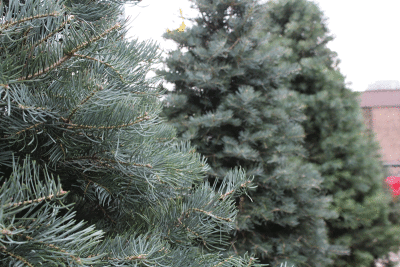
Products that can protect trees from drying out are common and recommended for some species of trees during the winter months.
Photo provided by John Steinkopf
METRO DETROIT — Fall is approaching, and for those who want their lawns and gardens to stay healthy in the winter and come back green in the spring, there are many helpful tips that lawn care specialists and horticulturalists recommend.
Whether it’s fertilizing, trimming or protecting flora against animals, there’s a variety of steps homeowners can take.
“There’s lots of things you can be doing at this time of year,” said Heather Glenday, the manager of Bordine’s of Rochester Hills. “Fertilizing and watering is good to do before it gets cold. Doing this will help keep the ground hydrated and healthy before the ground freezes, especially for trees and shrubs with deeper roots. You want to give them a good dose of fertilizer and water going into winter.”
John Steinkopf, the co-owner of the Steinkopf Nursery in Farmington Hills, said that people should remember to prepare their lawns for the fall —not only their gardens.
“A lot of people will do lawn repair in the fall, where there are stretches of dry weather in the summer, so they will come in and get new soil and seed and something to cover up the seed to keep the birds away,” he said. “Aeration also is great to do in the fall. You want to bring those plugs up so more air and water and fertilizer can get to the root zone.”
“You definitely want to get nitrogen into the lawn before the frost. It winterizes the lawn and gives it something to feed off of before they go dormant in the winter. You also want to watch out for grubs, which will feed on the roots of the grass,” added David Doyle, of Blue Grass Inc. in Clinton Township. “You just need to prepare the grass for dormancy. This time of year is mostly about spot control and maintenance. Winterize the lawn and keep the soil moist.”
Steinkopf said the main concern with lawns in the winter is staying healthy during the cold weather so they can bounce back in the spring.
“In preparation for winter, it’s good to put down fertilizer on the lawn,” he said. “That is best done later in the season to promote growth in the spring. Adding mulch or seed accelerator also can be a good idea. They protect the seeds and help protect the seeds from birds and help spread moisture.”
Even with the onset of cooler weather, gardening doesn’t have to stop.
“If your containers are looking a little ragged, you can add some color with some pansies, mums, cabbage and kale, since they are all good choices to plant as temperatures go down,” said Glenday. “Fall is a good time to plant with the cooler weather. It also is a good time to clean up dead foliage or trim back perennials if anything is diseased or wilting. Summer flowering shrubs, spirea, weigela and hydrangeas are good to trim back. Things that flower in the summer can be trimmed, but those that flower in the spring, you never want to trim back because they won’t bloom in the spring.”
“Fall is a tremendous time to plant,” added Steinkopf. “Soil temperature is cooler, it’s not as hot out. Plants won’t be as stressed out because of the temperature, so all plants are doing is putting down roots. Trees, plants, everything. There are so many variables that come into play in the winter to protect them. Keep watering them until the ground is frozen, which can be as late as December. Put down mulch around what you plant. You need that soil under the ground to stay moist.”
There are several other concerns that homeowners can address outdoors when the temperatures go down.
“Crabgrass is a seasonal grass, and in the spring, you want to use preventative materials to slow the growth of it,” said Doyle. “There are chemical and granular compounds you can add to the grass after the lawn thaws out.”
Preserving trees to ensure they don’t dry out also can be important.
“For broadleaf evergreens like holly and azaleas, winter winds can damage them,” said Glenday. “We suggest a product called Wilt Stop. You spray it on the plant, and it acts like ChapStick, where it keeps the moisture in the plant but still allows them to breathe.”
Glenday added that guarding trees against deer also can be very important.
“In this area, we have a large population of deer,” she said. “From about October through November is called ‘rutting season,’ and bucks come along and scratch their antlers on anything they can. This can damage new trees, so you can surround them with chicken wire or other coverings. That scratching can permanently damage the young trees.”
Lastly, experts suggest using the autumn as a time to trim back plants that have wilted or overgrown during the summer.
“The old rule of thumb is, once your annual flowers are looking poorly or we have a killing frost, usually in late October, you want to pull those out,” said Steinkopf. “You can recycle them or compost them. With perennials, depending on the variety, you can trim those down. Again, it depends on the variety, but for many of them, the rule is, ‘if they’re brown, trim them down.’ There are a handful of perennials you shouldn’t cut down to the ground, so you should consult a florist or garden expert on the specific variety.”
 Publication select ▼
Publication select ▼























